If you want your yard to be as beautiful in the fall as it is in the summer season, be sure to plant asters. There are dozens of varieties of asters, the best of them are used for cutting, composing landscape compositions and original herbariums. Growing aster flowers does not require any special conditions : they grow well in any soil and easily tolerate partial shade.
How to propagate asters, how and when to plant flowers with seeds
These are the most popular flowers of the second half of summer and autumn. Valued for exceptional durability when cut. Under normal room conditions, they are stored in water for 2-3 weeks.
How can asters be propagated in the garden? Propagation of plants is carried out by sowing seeds in the ground and seedlings.
Seeds of asters, when stored at room conditions, lose their germination capacity after 2 years. When stored in the refrigerator, their viability increases significantly.
Before planting asters, they are immersed for 30 minutes in a three-day infusion of calendula seeds (1 tablespoon per 100 ml of water). Spraying such an infusion of flower crops protects them from pests and diseases.
When should asters be planted with seeds for growing seedlings? Planting material is sown in early March. Mass seedlings appear on the 6th-7th day. The most favorable temperature for germination is +18…20°С, and +15…16ᵒС is sufficient for normal seedling growth.
And how to grow asters in the open field? Seedlings are planted in late April-May. In flower beds, the distance between plants is 15-25 cm, depending on the variety (undersized curb varieties are planted thicker).
Astra can be sown in the ground before winter, as well as in early spring on the area prepared in the fall. Manure is not applied under asters, but they give a sufficient amount of mineral fertilizers (up to 80 g per 1 m2 of a flower bed).
Planting, care and growing conditions for asters from seeds (with photo)
This page contains photos of planting and caring for asters, as well as recommendations for creating conditions for successful growing plants.
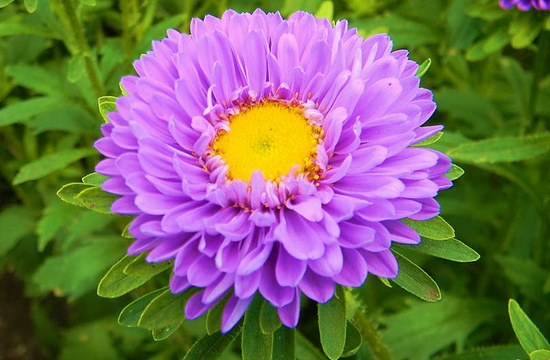
Astra is a photophilous plant. It is undemanding to the soil, but it grows better on chernozem or sandy and loamy soils.
In hot and dry weather, the doubleness of the inflorescences decreases and the number of seeds set decreases.
How to care for asters to ensure their long flowering? Plants tolerate small spring and autumn frosts (-4…-5°С) well. When growing and caring for asters, they need to be regularly watered, weeded, loosened the soil, and deal with pests and diseases.
Flowering occurs 3.5-4 months after sowing and continues until severe frosts. A separate inflorescence blooms for 20-40 days. Seeds ripen 35-40 days after the start of flowering. In 1 g there are 300-500 pieces.
When planting and caring for asters, remember that these plants are cross-pollinated, therefore, spatial isolation is necessary to maintain the variety, at least 5-10 m.
The variety of colors and shapes of inflorescences, different heights and shapes of the bush make it possible to widely use asters in the flower arrangement of garden, summer cottage and household plots, as well as grow them as a pot and cut crop.
Having created the right conditions for growing asters, remember that the flowers cannot be cut immediately after watering: the petals will quickly rot and lose their decorative effect.
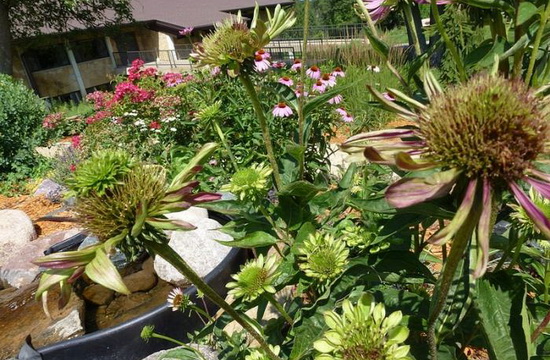
Fusarium is a threat to asters. The disease of asters will be significantly reduced if garlic is planted among them. Against Fusarium wilt, asters are effectively grown next to nasturtium and petunias .
What are asters and what do they look like?
What does an aster flower look like, and what varieties are recommended for growing in the middle lane?
According to the height of plants, asters are distinguished high (50-75 cm), semi-high (30-50 cm) and low (15-20 cm); in shape – columnar, slightly branched – shoots of the first order are directed upwards at an acute angle (20-25 °), sprawling – the angle of departure of shoots of the first order is 50-60 °; bouquet – a highly branched bush with numerous flowering shoots of the second and third orders, the inflorescences on them bloom almost simultaneously, which gives the bush the shape of a bouquet; hemispherical – the height of the bush is less than the diameter.
In different groups of asters, the inflorescences range in size from 3-4 to 15 cm. The shape distinguishes spherical, radiant, needle-shaped; according to the structure of flowers – peony-shaped, rose-shaped, chrysanthemum-shaped.
Among the asters there are varieties of a wide variety of colors – from white to dark red, from blue to dark purple.
What are asters and what is their peculiarity? Below are photos of the best varieties of asters and their description:
“Camelot” (white) is a new variety series of English selection with exceptional decorative qualities.
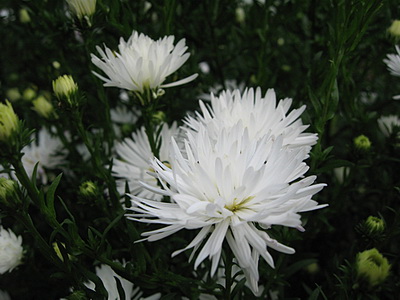
Asters of this group form dense, low, about 25-30 cm, bushes of a pyramidal type. Flowers of the original structure, very large, 12-14 cm in diameter. Plants form 10-14 flowers. Unlike other large-flowered groups, Camelot looks great in flower beds and is not afraid of rain. A distinctive feature of the Camelot group is the versatility of using a cut , designing flower beds , balcony boxes , and curbing.
“Corrida” (carmine) – a new variety series of tall, up to 80 cm, large-flowered cut asters.
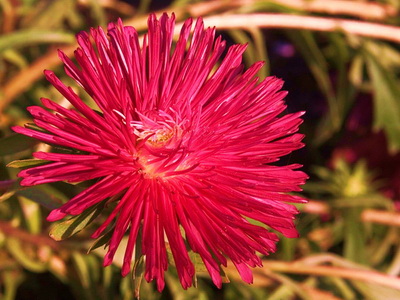
Asters of this group are also good for group plantings. Plants form up to 10-15 large flowers on strong peduncles. A distinctive feature is the exceptional quality of the huge inflorescences. Good rain resistance and cutting properties.
“Shanghai Rose” (blue) – a giant cut aster, intermediate in variety type between peony and “Princess”. Plant height 60-80 cm. Forms terry bicolor inflorescences of unusual size and shape.
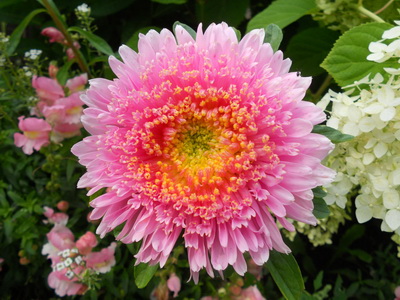
“Don Juan” (group “Matador”) – asters of the new Matador series, a unique selection of cut asters protected by patents.
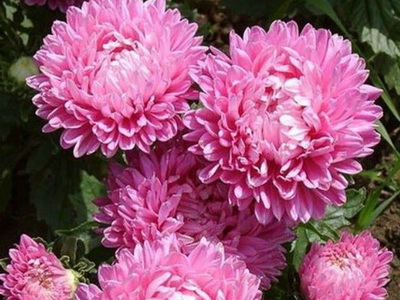
They have an unusual shape, as the parent forms are potentially different types – peony and “Princess”, and exceptionally large flower sizes (up to 18-20 cm in diameter). The plant is tall, powerful (80-100 cm), branching comes from below. The buds are laid early, but the full development of the flower requires a significant (up to three weeks) time. Plants are demanding for care and show all their inherent qualities only under optimal conditions.
“Lady Coral White”.A fundamentally new spectacular variety series of asters. Powerful plants with a height of 60-70 cm form many magnificent double flowers. The flowers are large – 12-16 cm in diameter.

An important feature of the series is the exceptional density of inflorescences, the flowers are so large that they practically do not suffer from rain and can stand in the cut for a very long time. The purpose is universal – they look great in flower beds and are magnificent in bouquets . The series has no analogues among other groups of asters and is presented on the world market for the first time.
“Old Castle” (golden) – is a continuation of the selection of this variety type.
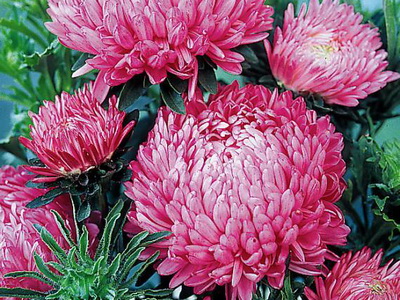
The annual work in the field of improvement of the group “Old Castle” made it possible to obtain varieties with more stable properties than the previous varieties of this series. It was possible to radically improve the evenness of flowers, significantly increase the decorativeness of plants, and achieve a stable large-flowered group. Asters of the “Old Castle” group form a typical pyramidal bush 60-70 cm high. The bush gives up to 10-12 strong peduncles with flowers up to 8-10 cm in diameter. The main purpose of the group is cutting, they are also good in group plantings.
Astra “Russian size 1” (“Topaz”, “Pearl”, “Tourmaline”, “Aquamarine” and their mixture) – with the largest inflorescences among needle asters. Blooms from mid-summer to late autumn.








